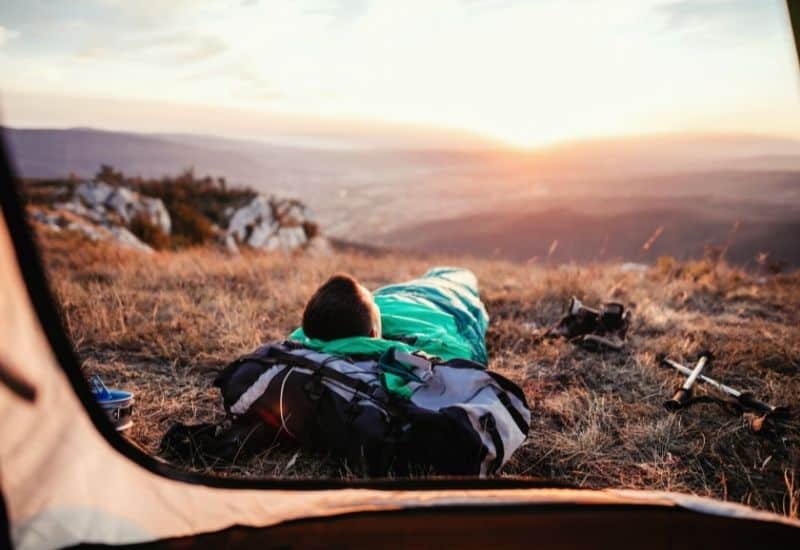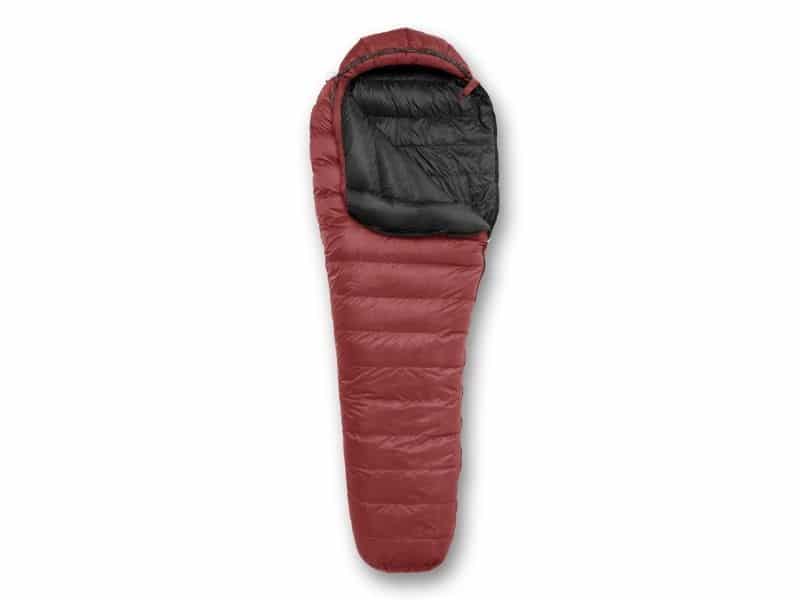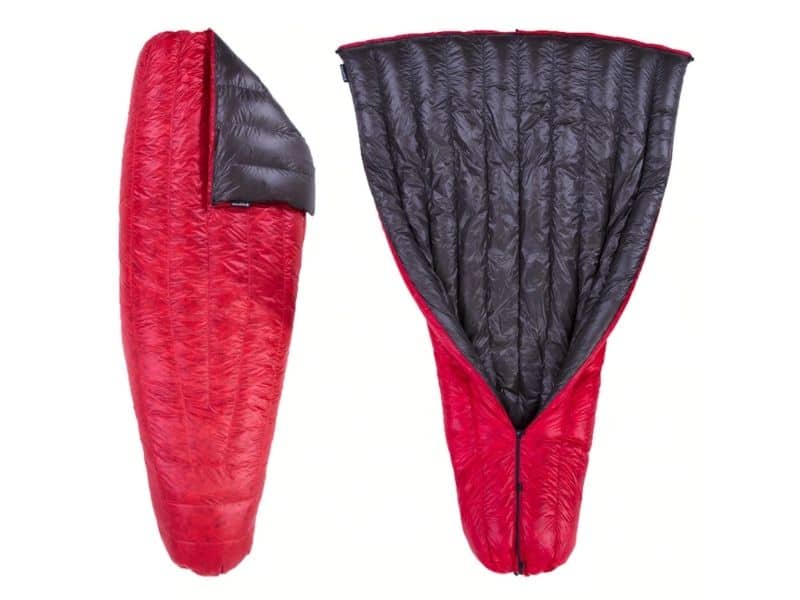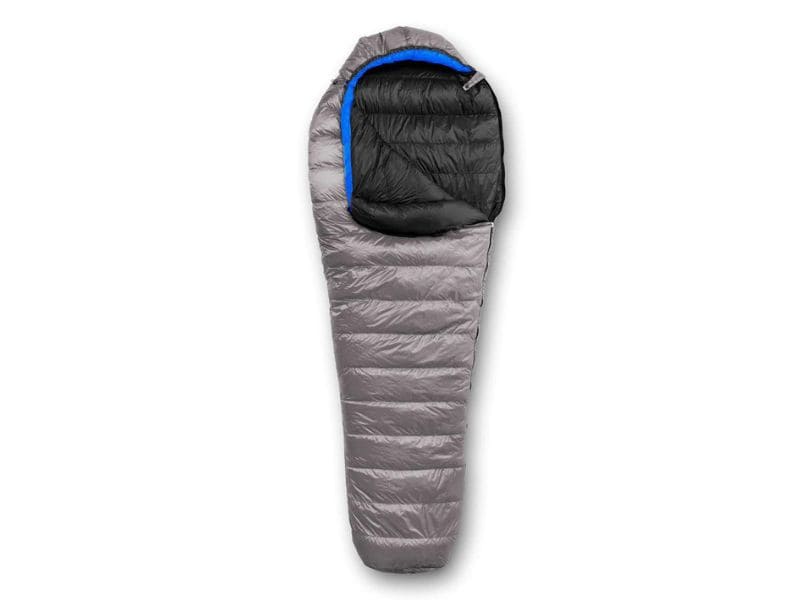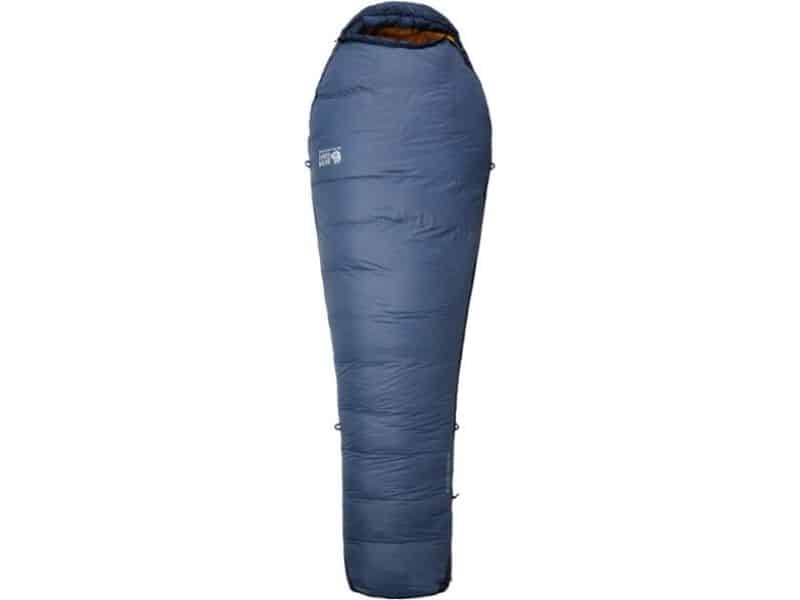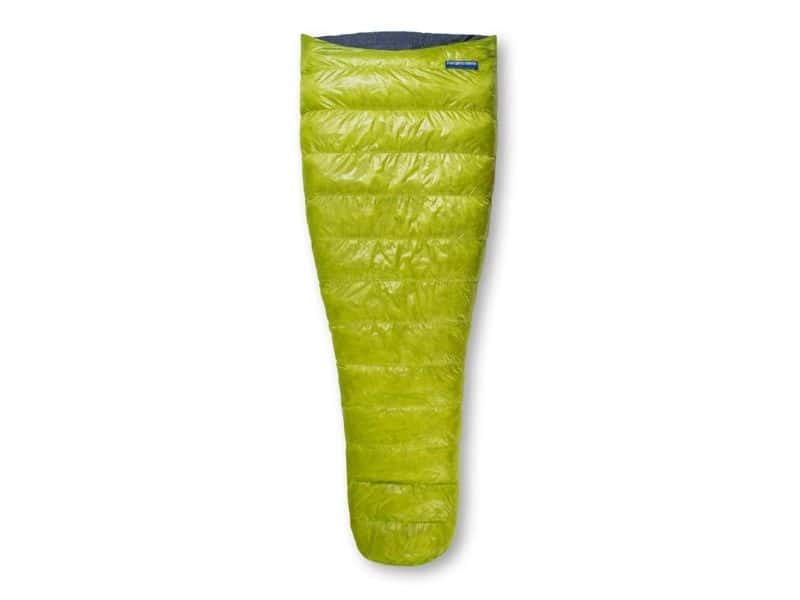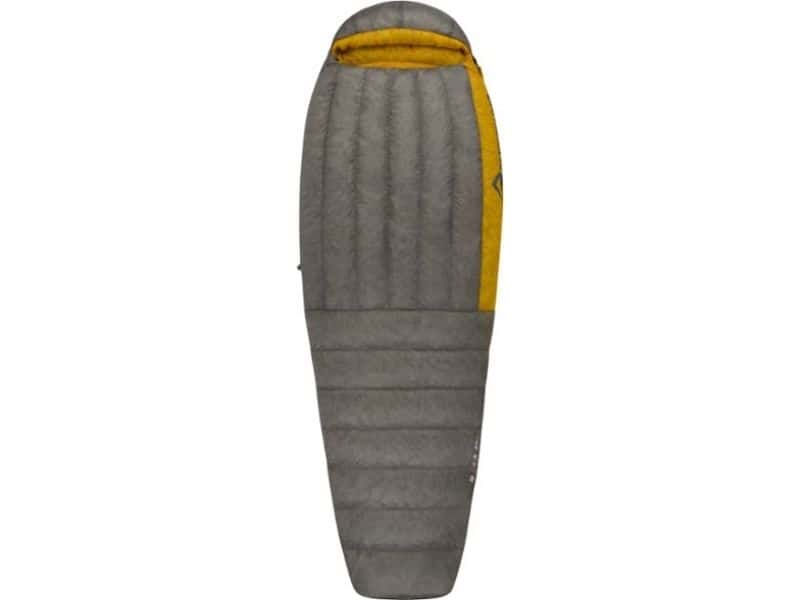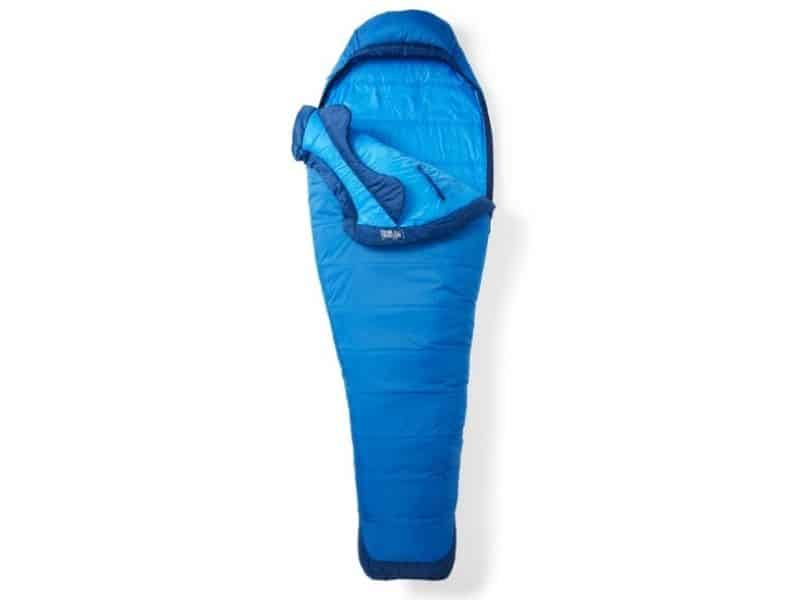Every backpacker knows that a good night’s sleep is crucial to recharge after a day on the trail, but choosing a sleeping bag that offers comfort, warmth, and portability can be a challenge. Faced with varying temperatures, unpredictable weather, and the need to keep the backpack light, finding that perfect balance of features often seems like an elusive task.
Nobody wants to be stuck shivering through a cold night or lugging around an overly bulky bag. That’s why we’ve dedicated this article to helping you find the best backpacking sleeping bag, ensuring restful nights and delightful mornings, preparing you for each day’s journey ahead.
Whether you’re looking for a summer sleeping bag or the warmest sleeping bag your money can buy, we’ll review 11 of the top backpacking sleeping bags of 2024, explain why the Feathered Friends Hummingbird 30 is our pick for best overall backpacking sleeping bag, and explain what features to consider when buying sleeping bags for backpacking.
Table of Contents
- Which Model Is The Best Backpacking Sleeping Bag?
- Feathered Friends Hummingbird 20
- Enlightened Equipment Revelation Quilt 10°
- Kelty Cosmic Down 20°
- NEMO Disco 15°
- Feathered Friends Swallow UL 30
- Mountain Hardwear Bishop Pass 15
- Big Agnes Sentinel 30 Double
- Feathered Friends Tanager 20 CFL
- Sea To Summit Spark SpII 28
- Marmot Trestles Elite Eco 20
- The North Face Eco Trail Synthetic 20
- Backpacking & Camping Sleeping Bag Comparison Table
- How To Choose The Best Lightweight Backpacking Sleeping Bag?
- Sleeping Bags Vs. Backpacking Quilts
- Conclusion
At A Glance: Sleeping Bag Recommendations
-
Best Overall:
Feathered Friends Hummingbird 20F
“A backpacker favorite, the Feathered Friends Hummingbird 20 is lightweight, packable, and warm.” -
Best Backpacking Quilt:
Enlightened Equipment Revelation Quilt 10°
“If you’re an active sleeper or want a versatile sleep system, the Enlightenment Equipment Revelation quilt is worth considering.” -
Best Budget Down:
Kelty Cosmic Down 20°
“If your goal is comfort and warmth on a budget then the Kelty Cosmic Down 20 might be the perfect choice for you.” -
Best Budget Synthetic:
Marmot Trestles 15
“If you’re looking for an affordable backpacking sleeping bag, the Marmot Trestles Elite Eco is a great choice, providing great warmth at a reasonable price.” -
Best Bag for Side Sleepers:
NEMO Disco 15°
“Active and side sleepers who want a more spacious sleeping bag should take a long hard look at the NEMO Disco 15, which offers more room than any other lightweight choice on our list.” -
Recommended:
Feathered Friends Swallow UL30
“An excellently designed hood and zipper combined with a great warmth-to-weight ratio make the Swallow a joy to sleep in.” -
Best Value:
Mountain Hardwear Bishop Pass 15
“The Mountain Hardwear Bishop Pass 15 has a good warmth-to-weight ratio and is a reasonably priced 3-season bag.” -
Best Double Sleeping Bag:
Big Agnes Sentinel 30 Double
“Want a lightweight sleeping bag that can keep both you and your significant other cozy on the trail? Our top pick is the Big Agnes Sentinel Double” -
Best Warmth-to-Weight Ratio:
Feathered Friends Tanager 20 CFL
“The Feathered Friends Tanager 20 CFL is one of the leading ultralight sleeping bags because of its minimalist lightweight design and its top-of-the-field warmth-to-weight ratio.” -
Best Ultralight Sleeping Bag:
Sea to Summit Spark SpIl
“Despite strong competition, the lightest bag on our list, the Sea to Summit Spark Spll is our top ultralight pick.” -
Most Durable:
The North Face Eco Trail Synthetic 20
“If you’re looking for a durable synthetic bag that will see you through occasional backpacking as well as car camping trips, then we recommend the TNF Eco Trail 20.”
Which Model Is The Best Backpacking Sleeping Bag?
Field-tested, here are our picks for the best sleeping bags for backpacking in the list below.
- Feathered Friends Hummingbird 20
- Enlightened Equipment Revelation Quilt 10°
- Kelty Cosmic Down 20°
- NEMO Disco 15°
- Feathered Friends Swallow 30
- Mountain Hardwear Bishop Pass 15
- Big Agnes Sentinel 30 Double
- Feathered Friends Tanager 20 CFL
- Sea to Summit Spark SpII 28
- Marmot Trestles Elite Eco 20
- The North Face Eco Trail Synthetic 20
Feathered Friends Hummingbird 20
Editors Choice20℉ Comfort Limit (~12℉ Lower Limit) temperature rating ⸱ 950+ fill-power 14 oz fill weight goose down ⸱ 58” / 52” / 38” shoulder/waist/feet measurements ⸱ 1 lb 8 oz / 9 liter packed ⸱ Pertex® Endurance® UL shell
The Hummingbird is lightweight, packable, and uses high-end down to deliver a super warm and comfortable bag. A perennial favorite among trailgoers, it’s a worthy winner of our best backpacking sleeping bag award.
At 950+ fp the Hummingbird uses highest quality down available. The use of premium fill-down results in an ultralight mummy bag that weighs 1 lb 8 oz and packs down to just 9 liters. It also makes it as comfortable and cozy as sleeping bags come.
The temperature rating of 20℉ (lower limit) combined with low weight marks this model out as one of the best warmth-to-weight ratios on our list. It also makes it great for cold sleepers or those who plan on backpacking or camping in the shoulder seasons.
The high warmth rating is tied to the slender profile of the Hummingbirds shape, which is both a strength and weakness. The 58”/52” shoulder/waist measurement is one of the narrowest we came across in testing, so larger folks and active or side sleepers may feel a little claustrophobic. On the plus side, this narrow profile improves thermal efficiency on cold nights.
PROs
- Premium quality down fill
- Lightweight & packable
- Cozy and warm bag
CONs
- Pricy
- Very narrow around the shoulders
- Availability
Bottom-Line: The Feathered Friends Hummingbird 20 is a backpacker favorite for all the right reasons – it’s lightweight, packable, versatile, and warm.
Enlightened Equipment Revelation Quilt 10°
Best Backpacking Quilt10℉ Lower Limit (~35℉ Comfort Limit) ⸱ 850 fill-power 17.87 oz fill weight goose down ⸱ Weight: 1 lb 14 oz ⸱ 10-denier shell & liner
The Enlightened Equipment Revelation is a versatile, handcrafted and great value quilt that’s our top pick for warmer-weather backpacking or backpackers who like a little more legroom.
The Revelation is available in six different temperatures ratings, ranging from 0℉ up to 50℉, so it’s easy to find one to suit the climate you’ll be camping in. While the Revelation can be cinched closed around the footbox area it will be draughtier than a traditional mummy bag, meaning that the comfort rating is closer to 15-25℉ higher than the Lower Limit (dependent on whether you’re a hot or cold sleeper).
The Revelation is filled with 850 FP goose down and uses 10D shell and inner liner fabrics to keep you toasty while keeping the weight down. This, in combination with the lack of full zip, means the Revelation weighs just 1 lb 14 oz, giving it a great warmth-to-weight ratio.
The main benefits of this quilt are versatility and the roomier fit. Having that full-length zipper allows you to use it as either a bag or duvet while the baggier sizing makes it more suitable for side and restless sleepers.
The off-the-shelf version of the Revelation is available in four sizes, but if you’re willing to pay a little more (and wait a little longer) you can order a bespoke model, choosing your preferred down type, temperature rating, length, width, and colors. You also have the option to add a draft collar.
The biggest downsides to the Revelation are that there’s no hood and a bigger gap between the Lower Limit and the Comfort Limit. If you’re planning on camping outside of summer, therefore, it’s best combined with a sleeping bag liner and/or a high R-value sleeping pad.
*All specs listed are for the 10℉ version of the quilt.
PROs
- Very versatile
- Great value for money
- Highly customizable to your needs
- Excellent US craftsmanship
CONs
- Care needed with the thin materials
- Not warm enough above the treeline or for winter use
- Custom orders can take some time
Bottom-Line: Active sleepers or those who want a more versatile sleep system will love the lightweight and comfortable Enlightenment Equipment Revelation quilt.
Kelty Cosmic Down 20°
Best Budget Sleeping Bag21℉ Lower Limit (32℉ Comfort Limit) ⸱ 550 fill-power 16.37 oz fill weight goose down ⸱ 62” / 58” shoulder/waist measurements ⸱ 2 lb 13.5 oz / 10.7 liter packed ⸱ 20-denier ripstop nylon shell
The Kelty Cosmic Down 20℉ is one of the cheapest down sleeping bags available, but don’t let the low price tag fool you. This is still a high-quality mummy bag and a worth winner of our best budget backpacking sleeping bag award.
The Cosmic Down use 16.37 ounces of 550FP goose down stuffed into trapezoidal baffles, creating a bag with a Lower Limit of 21℉ and a Comfort Limit of 32℉ (it’s also available in a 0℉ and a 40℉ version). That 32℉ limit should easily see you through all but the chilliest of nights in the shoulder season in comfort.
While warm and cheap, there’s a trade-off with weight and packed size. Weighing 2 lb 13.5 oz., and packing down to 10.7L, it’s one of the heaviest and bulkiest down bags on our list. However, it’s significantly smaller than comparable synthetic bags such as the Marmot Trestles 15.
The CD is available in three sizes (short, regular, and long), with the regular offering 62” around the shoulders and 58” around the waist. It is also available in a women’s sleeping bag version.
If you need to knock off a little weight, and your budget can stretch a little further then the Mountain Hardwear Bishop Pass is a slightly more expensive option but shaves nearly a pound off the total weight.
PROs
- Amazing price for a down bag
- Warm
- Zippered stash pocket
- Tough shell fabric
CONs
- Heavy for its temperature rating
- Cheaper feel compared to the premium competitors
Bottom-Line: If budget is a concern, or you are a novice backpacker, then the Kelty Cosmic Down 20 is a great pick.
NEMO Disco 15°
Best Bag For Side Sleepers15℉ Lower Limit (~25℉ Comfort Limit) ⸱ 650 fill-power 22 oz fill weight goose down ⸱ 64” / 59” / 62” shoulder/waist/foot measurements ⸱ 2 lb 11 oz / 12.5 liter packed ⸱ 30D/40D Ripstop nylon w/DWR
The NEMO Disco is an excellent choice of sleeping bag for backpackers who like a little more room, or are cold sleepers or plan on backpacking in cooler climes.
The spoon-shape design gives the Disco significantly more room around the waist and feet compared to most sleeping bags. Measurments of 64”/59”/62” (shoulder/waist/feet) make it by the far the roomiest model on our list. This makes the NEMO Disco a good option for active or side sleepers who feel uncomfortable in mummy bags.
The Disco comes in both mens and women’s versions and is rated to 15℉ lower limit (30℉ available). While warm, our testers were particularly enthusiastic about the Disco’s temperature regulation. This comes courtesy of the bag’s proprietary Thermo Gill™ vents, which allow you to release body heat without letting cold drafts in.
The Disco also other technical features that just make it stand out. This includes a DWR footbox, a pillow sleeve in the hood, and a Blanket Fold™ draft collar that lets you feel nicely “tucked in”.
At 2 lbs 11 ounces overall, and with a stuff sack size of 12.5L, this is a hefty and bulky down bag. Nevertheless, it’s a winner if comfort and warmth are your main priorities.
PROs
- Extremely roomy and comfortable
- With 30/40D materials more durable than most bags
- Thermo Gills are a very cool (get it?) design feature
- Built-in pillow pocket
CONs
- Heavy and bulky for a down sleeping bag
Bottom-Line: Active and side sleepers who want more room a long hard look at the NEMO Disco 15, the most versatile sleeping bag on our list.
Feathered Friends Swallow UL 30
Recommended20℉ Comfort temperature rating ⸱ 950+ fill-power 13.6 oz fill weight goose down ⸱ 60” / 56” / 38” shoulder/waist/feet measurements ⸱ 1 lb 9 oz / 8-liter packed size ⸱ Pertex® Endurance® UL
The Feathered Friends Swallow 30 sleeping bag is a perennial favorite among trailgoers owing to its well-thought-out features, toasty insulation, and packability.
The Swallow’s 950+ fill power makes it one of the highest-quality bags we tested. Our testers were amazed by (and in love with!) the amount of loft and its excellent warmth-to-weight ratio. At 1 lb 9 oz., it’s a little heavier than other 30-degree bags we tested, but those few ounces are accounted for by a wider fit, tough shell, and a comfortable lining – all well worth having.
The features in this bag also impressed in the field, particularly the fuss-free zipper and well-designed hood. Less impressive is the lack of a draft collar, but this wasn’t a dealbreaker.
The Swallow is a little heavier than the Hummingbird, but it’s also more spacious, measuring 60″ at the shoulders and 56″ at the hips (compared to 56″/52″). This makes it a great option if you’re a restless sleeper, side sleeper, or just prefer a little legroom.
PROs
- Premium quality down fill
- Lightweight and packable
- Cozy and warm sleeping bag
CONs
- Pricey for a 30-degree bag
Bottom-Line: Lightweight, packable, and warm – the ideal summer backpacking sleeping bag.
Mountain Hardwear Bishop Pass 15
Best Value15℉ Lower Limit (~25℉ Comfort Limit) temperature ratings ⸱ 650 FP goose down ⸱ 1 lb 12.6 oz / 9.6 liter packed ⸱ 20D Ripstop Nylon with DWR
The Mountain Hardwear Bishop Pass 15 is a great value buy if your budget can’t stretch to a higher-end premium bag.
While weighing 2 lbs 5.4 oz, the Bishop Pass 15’s lower temp rating (15℉)makes it more versatile and suitable for summer, spring, and fall nights. Our testers mostly agreed that having a quiver-of-one bag was a ‘pro’ (it saves you buying another for other seasons), but only if you do some of your backpacking in colder climates or outside of the summer months.
The other downsides noted by our testers were a trimmer profile around the hips, which may be a little too tight for more active sleepers, and the 12.25-liter packed size. However, bags with this temp rating often cost significantly more, so it’s well worth a punt if you’re a colder sleeper and are happy carrying an extra few ounces.
PROs
- Great low weight
- Great price
CONs
- Narrow dimensions around the hips
- Average insulation and fabrics
- Basic design
Bottom-Line: The Mountain Hardwear Bishop Pass 15 is a solid but basic 3-season bag with a reasonable warmth-to-weight ratio at a brilliant price.
Big Agnes Sentinel 30 Double
Best Two Person30℉ Lower Limit (~45℉ Comfort Limit) ⸱ 650 fp 20 oz fill weight goose down ⸱ Weight: 1 lb 12.6 oz / 9.6 liter packed ⸱ 105 / 105 / 84 shoulders/waist/feet measurements ⸱ 20D Ripstop Polyester Shell
The Big Agnes Sentinel 30 DoubleOne wins our testers’ vote as the best sleeping bag for couples courtest of its affordable pricing, roominess, and high-quality build.
This 105” doublewide bag is filled with 20 ounces of 650 fill DownTek™ goose down and is rated to 30℉(lower limit). This makes it good for most summer adventures. The Sentinel has a loose fit, so it’s susceptible to cold air creeping in and, therefore, runs colder than the lower limit – worth bearing in mind when buying.
The Sentinel has several interesting features such as a pillow sleeves to stop your pillows from wandering mid-slumber and an internally cinched hood drawcord that ensures you’re not groping around in the cold. It also has a stretchy sleeping pad sleeve and pad coupler that allows you to attach your pads easily.
The drawbacks with the Sentinel are common to all doublewide bags — packed size, weight and warmth. Weighing a hefty 3 lb 8 oz and with a packed storage sack size of 20.9L, the Sentinel is going to take up a lot of room in your backpack.
PROs
- All the spaciousness you’d expect
- Great price
- Versatility
CONs
- Not the warmest bag
- Bulky and heavy
Bottom-Line: If you are on the hunt for a double bag for future backpacking trips with your significant other, then the Big Agnes Sentinel Double is our top pick.
Feathered Friends Tanager 20 CFL
Best Warmth To Weight Ratio20℉ Lower Limit (~30℉ Comfort Limit) temperature ratings ⸱ 950+ FP 12.6 oz fill weight goose down ⸱ 62″ / 52″ / 38″ shoulder/waist/feet measurements ⸱ Weight: 1 lb 4.6 oz ⸱ Pertex® Quantum® 7D
The Feathered Friends Tanager 20 sleeping bag is one of the best ultralight sleeping bags on the market. It’s simple, light as a feather, and amazingly warm for the weight.
The Tanager packs 12.6 ounces of 950+ fill goose down and has a cozy lower limit of 20℉, which will see you through most 3-season backpacking trips. Given that it weighs just 1 lb 2.6 ounces, the 30℉ comfort limit is the best warmth-to-weight ratio we have seen.
Like many ultralight sleeping bags, one area that the Tanager cuts weight is by using thin materials in the construction. The Pertex® Quantum® 7D fabric is the thinnest material we’ve seen used, and it does require an extra level of care around the campsite.
To strip back the weight further the Tanager does not feature a hood, and rather than a zipper running the length of the entire bag, FF has done away with it completely. If you don’t mind the extra wiggle/dexterity it takes to get in/out of your bag, great. If you prefer convenience, look elsewhere.
Overall, this is one of the best sleeping bags out there for the weight-conscious backpacker and features the highest warmth-to-weight ratio we’ve seen. The title of best ultralight, however, goes to the Sea to Summit Spark due to its lighter weight and inclusion of a hood and a zipper.
PROs
- Simple ultralight design
- Best in class down insulation
- Amazing warmth-to-weight ratio
CONs
- Super-thin materials
- No zipper or hood
Bottom-Line: The Feathered Friends Tanager 20 CFL is one of the most popular backpacking sleeping bags amongst the ultralight community due to its bare-bones, lightweight design and superb warmth-to-weight ratio.
Sea To Summit Spark SpII 28
Best Ultralight Sleeping Bag28℉ Lower Limit (~38℉ Comfort Limit) ⸱ 850+ FP 10.6 oz fill weight goose down ⸱ 59” / 51” / 35” shoulder/waist/feet measurements ⸱ Weight: 1 lb 1.3 oz / 6 liter packed ⸱ 10D nylon shell
The Sea to Summit Spark SPll 28 is an amazingly lightweight and packable bag that still packs a lot of warmth, making it ideal for summertime backpackers keen to shed every ounce.
The Spark weighs an incredible 1 lb and 1.3 oz, making it the lightest bag we tested, beating the Tanager and Hummingbird by a few ounces. The high-quality, 850+ fill goose down means great compressibility and, as a result, a 6-liter packed volume – the smallest of all the bags we tested.
Despite its low weight and packed size, the Spark has a lower limit of 28℉, giving it one of the best warmth-to-weight ratios. While not warm enough for the shoulder season, this makes it perfect for summer backpacking in most regions.
The Spark has a 10D nylon shell and a 7D taffeta liner. As these are on the skinny side, it will require a little extra care. The only other downside is the fit. The Spark is the trimmest model on our list with shoulder/hip/feet dimensions of 59”/51”/35” — if you hate being restricted in your bag or are a larger backpacker, then the Tanager and Disco are better options.
PROs
- Lightest and most compact sleeping bag we tested
- Excellent warmth-to-weight ratio
- High-end down insulation
Bottom-Line: Hands down the best ultralight sleeping bag out there!
Marmot Trestles Elite Eco 20
Best Synthetic21.6℉ Lower Limit (32.2℉ Comfort Limit) temperature ratings ⸱ HL-ElixR ECO” Recycled Fibers ⸱ 60” / 56” shoulder/waist measurements ⸱ 2 lb 6 oz / 8.4 liter packed ⸱ 40d 100% Nylon Ripstop
The Marmot Trestles line of bags may be just the ticket if you’re looking for a synthetic sleeping bag or have a tighter budget. We tested the 20-degree version, which has a great temperature rating and an amazing price.
The Trestles comes in multiple temperature ratings (0℉, 20℉ & 30℉), all of which use HL-ElixR Eco Micro recycled synthetic fibers for insulation. The 20℉-rated bag packs has a comfort rating of 32.2°F, so is great for summer and warmer shoulder season backpacking. The synthetic insulation will also keep you warm when damp, which isn’t the case with down.
The biggest downside to the Marmot Trestles Elite Eco is its weight. While it packs down to 8.4 liters, the 20℉ version of the bag weighs 2 lbs 6 oz, which will make it a little too heavy for some.
PROs
- Affordable price tag
- Internal stash pocket
- Good temperature rating for a synthetic
- Durable shell & liner fabrics
CONs
- Heavy
- Tight around the footbox
Bottom-Line: If you’re looking for a cheap synthetic bag, then the Marmot Trestles Elite Eco is worth considering, providing great warmth for a brilliant price.
The North Face Eco Trail Synthetic 20
Most Durable20℉ Lower Limit (29℉ Comfort Limit) ⸱ 100% Recycled Polyester ⸱ 63” / 58” shoulder/waist measurements ⸱ 3 lbs / 19-liter pack weight ⸱ 50D 100% Recycled Polyester Ripstop
The North Face Eco Trail is a durable and roomy synthetic sleeping bag that is one of the cheapest we tested. It’s a great option if you are looking for an affordable car camping bag that’s good for the occasional short backpacking trip.
It is filled with 100% recycled polyester insulation which is rated to 20℉ lower limit (29℉ comfort), which should keep you toasty even if the temperature drops below freezing.
The Eco Trail is a roomy 63”/59” across the shoulders and hips, making it a good option for side and active sleepers. These spacious dimensions are only beaten by our top pick for side sleepers, the Nemo Disco 15℉, which is far pricier.
Using 30/40 Denier fabrics, the Eco Trail is the most hardwearing and durable of all the bags we tested. Great if you need something that can take a more punishment when your out in the wild.
The downsides to TNF Eco Trail are its weight and packed size. At a whopping 3 lbs 14 oz., it’s a heavy option. As with all synthetic materials, it’s less compressible than comparable down bags. Its pack volume of 19L makes it about 25% smaller than our other synthetic pick, the Marmot Trestles, but double the volume (or more) of most down bags.
Unless you really want a synthetic bag or want a more durable bag for a mix of short backpacking trips and car camping, then we’d pick the Cosmic Down over the TNF Eco Trail. That said, the Eco Trail is a solid bag at a very cheap price if you don’t mind its weight and packed size.
PROs
- Most durable shell/liner fabrics of the bags we reviewed
- Pretty roomy
CONs
- Very heavy, suitable only for short backpacking trips or car camping
- Synthetic insulation isn’t easily compressible so bulky packed size.
Bottom-Line: If you want a durable synthetic bag that will see you through car camping trips and the occasional (short) backpacking adventure then we’d pick TNF Eco Trail 20.
Backpacking & Camping Sleeping Bag Comparison Table
| Type | Temperature Rating | Fill Power | Measurements | Weight / Packed Size | |
|---|---|---|---|---|---|
| Feathered Friends Hummingbird 20 | Down | 20℉ Comfort (~12℉ Lower Limit) | 950+ FP | 58”/52”/38” | 1 lb 8 oz / 9L |
| Enlightened Equipment Revelation Quilt 10° | Down | 10℉ Lower Limit (~35℉ Comfort Limit) | 850 FP | N/A | 1 lb 14 oz |
| Kelty Cosmic Down 20° | Down | 21℉ Lower Limit (32℉ Comfort Limit) | 550 FP | 62”/58” | 2 lb 13.5 oz / 10.7L |
| NEMO Disco 15° | Down | 15℉ Lower Limit (~25℉ Comfort Limit) | 650 FP | 64”/59”/62” | 2 lb 11 oz / 12.5L |
| Feathered Friends Swallow UL 30 | Down | 20℉ Comfort | 950+ FP | 60”/56”/38” | 1 lb 9 oz / 8L |
| Mountain Hardwear Bishop Pass 15 | Down | 15℉ Lower Limit (~25℉ Comfort Limit) | 650 FP | N/A | 1 lb 12.6 oz / 9.6L |
| Big Agnes Sentinel 30 Double | Down | 30℉ Lower Limit (~45℉ Comfort Limit) | 650 FP | 105”/105”/84” | 1 lb 12.6 oz / 9.6L |
| Feathered Friends Tanager 20 CFL | Down | 20℉ Lower Limit (~30℉ Comfort Limit) | 950+ FP | 62”/52”/38” | 1 lb 4.6 oz |
| Sea To Summit Spark SpII 28 | Down | 28℉ Lower Limit (~38℉ Comfort Limit) | 850+ FP | 59”/51”/35” | 1 lb 1.3 oz / 6L |
| Marmot Trestles Elite Eco 20 | Synthetic | 21.6℉ Lower Limit (32.2℉ Comfort Limit) | N/A | 60”/56” | 2 lb 6 oz / 8.4L |
| The North Face Eco Trail Synthetic 20 | Synthetic | 20℉ Lower Limit (29℉ Comfort Limit) | N/A | 63”/58” | 3 lbs / 19L |
How To Choose The Best Lightweight Backpacking Sleeping Bag?
The first step in finding the best backpacking sleeping bag is to understand what your needs are and how they’ll be met. Below, we have summarized some of the most important considerations and decisions you’ll need to make to find a model to suit your needs.
- Sleeping Bag temperature ratings
- Down vs. Synthetic Insulation
- Fill Power
- Weight and Packed Size
- Durability and Shell Denier (D)
- Women’s Sleeping Bags
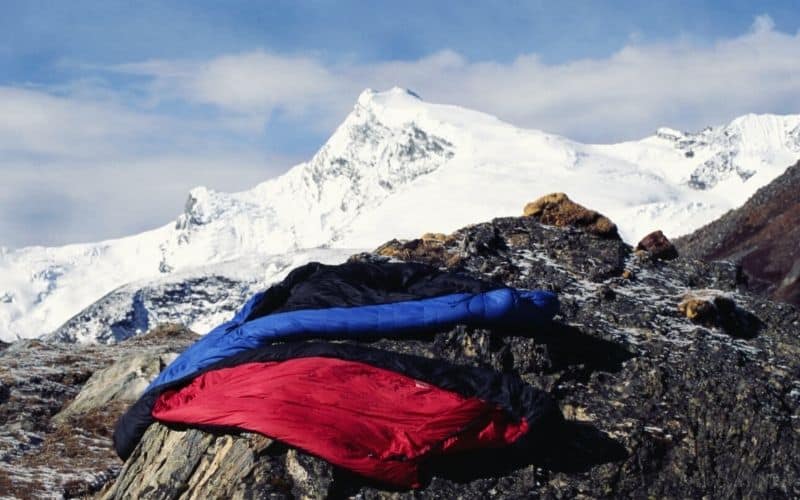
Temperature Rating (Warmth-to-Weight Ratio)
When choosing a sleeping bag, its temperature rating should be your top priority. However, as one of the heaviest items that you will carry (along with your sleeping pad, backpack, and shelter), striking a balance between warmth and weight is crucial.
Sleeping bags are rated with standardized temperature systems, such as European Norm (EN) or ISO.
Most bags are labeled using the EN Lower limit e.g. the NEMO Disco 15° has an EN Lower Limit of 15℉. The definition of Lower Limit is the temperature at which an average man can sleep for eight hours without waking. However, in our experience, this “average man” they use in testing is a darn deep sleeper.
The Comfort limit is defined as the temperature at which an average woman can sleep comfortably (women sleep colder than men).
RELATED: Best Cold Weather Sleeping Bags
The comfort rating gives a more realistic idea of how a bag will perform outside of the lab and we prefer to use this number against the lowest temperatures we might encounter.
If you want to choose the right rating, it’s a good idea to know the temperatures you’ll experience overnight by checking weather forecasts and average overnight temperatures at the time of year in the areas you plan to visit.
There are many factors that contribute to your overall warmth, meaning picking the right sleeping bag temperature rating is not an exact science. Your clothing, the altitude of your campsite, whether you are a “cold sleeper” or not, how well hydrated or fed you are, along with the ratings of the rest of your sleep system will play a role.
It’s common for frequent backpackers to own multiple sleeping bags rated for different temperatures. To keep costs down, most backpackers start with one that will keep them warm in the lowest temperatures they plan to camp in.
There are, however, multiple ways of increasing the temperature rating of your “sleep system” without owning several bags.
First is the R-Value of your sleeping pad. The underside insulation gets compressed under your body weight and becomes less effective at trapping heat. Your sleeping pad is there to help provide more insulation between yourself and the cold ground. A beefier pad will serve you better.
Simple and cost-effective methods to stay warm include wearing warm clothing such as wool base layers, a warm hat, gloves, and a down jacket when sleeping. A sleeping bag liner can also add 3-10℉ of warmth to your existing bag.
Other tricks to try:
- using a hot water bottle
- eating dinner right before bed
- keeping well hydrated
- Finding natural insulators to place under your pad
As most backpackers don’t limit themselves to summer adventures only, most sleeping bags on our list are rated to around 20F (Lower Limit), so they should comfortably see you through chilly spring or fall nights.
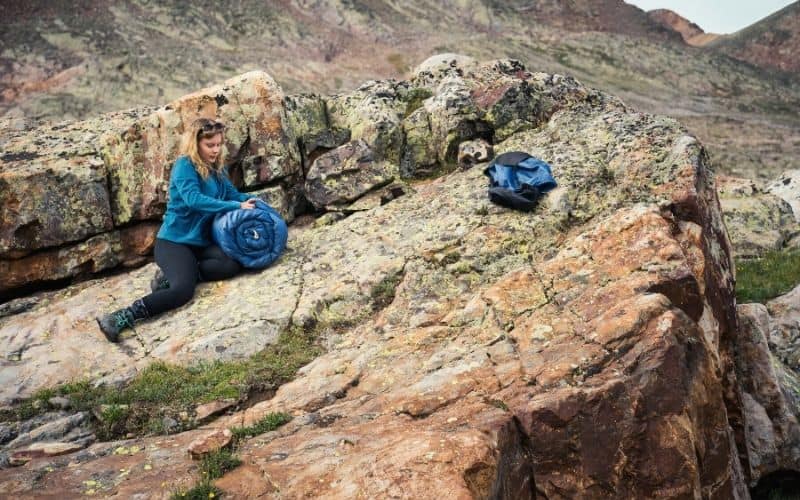
Down Vs. Synthetic Insulation
The next big decision when buying a sleeping bag is the insulation type: down or synthetic. Down insulation is more expensive but has a better warmth-to-weight ratio and compressibility than synthetics. This means you’ll get the same level of warmth with a smaller packed volume when opting for down.
Over the years we’ve found down bags also last longer if you take care of them properly.
Synthetic bags do have their advantages — they are cheaper than down bags and are able to retain heat better when damp or wet. This disparity has reduced in recent years thanks to companies applying water-resistant treatments to some (but not all) down bags to make them hydrophobic.
We think that if a down bag is within your budget, in most cases it’s going to be the better option.
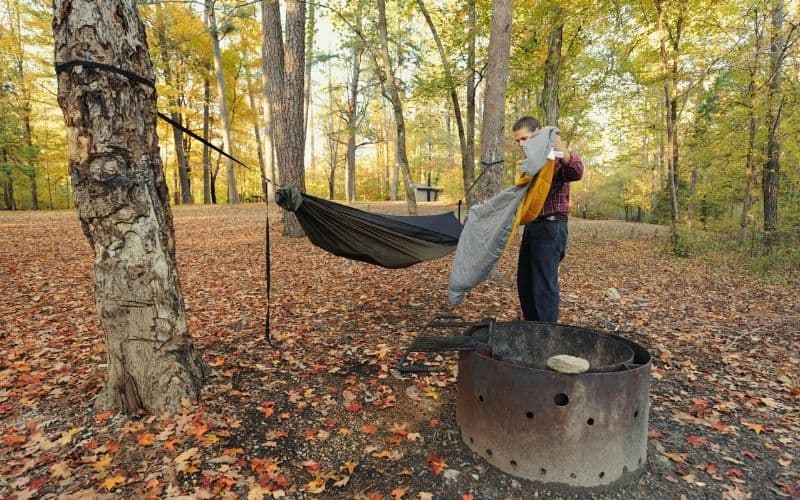
Fill Power
Another critical consideration when choosing a sleeping bag is fill power, which distinguish the quality of the down used.
Fill power is a measure of how much loft or fluffiness the down clusters have, and this correlates to warmth. The less fill power you have, the more the bag will have to weigh to give the same warmth.
The cheapest down bag on our shortlist is the Kelty Cosmic Down 20 with a 550 fill power and a 21℉ lower limit. A comparison with the 900+ Fill power Feathered Friends Swallow YF (20℉ lower limit) shows the Cosmic Down is nearly a pound heavier (13.3 ounces) and has the same temperature rating.
Second to fill power is fill weight. Fill weight is the amount of insulation that has been used in the sleeping bag. If you’re torn between two with similar insulation, look at the fill weight in order to determine which will be warmer. While this is a reasonable rule of thumb, it’s important to remember that a bag with a slender cut may have less insulation than a bag with a roomy cut.
From such a comparison you can see how much more insulation is needed for a synthetic bag to compete with down. The Marmot Trestles, which uses synthetic insulation, weighs over a pound more than similarly rated 20℉ down bags.
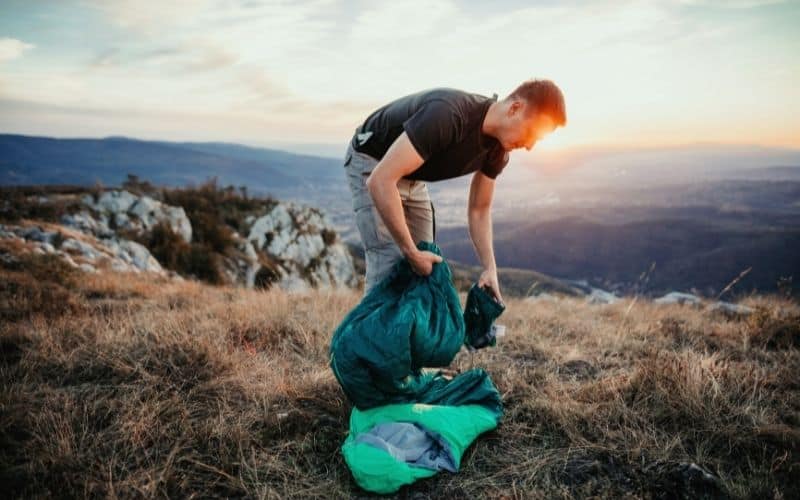
Weight And Packed Size
Your sleeping bag’s weigh and packed size is another vital consideration, especially for ultralight hikers. You bag is one of the heaviest and bulkiest items in your pack, so this where you can make significant weight and bulk savings. Ultralight sleeping bags can range from 1 pound for a premium model, to 3 pounds for a budget synthetic bag.
Weight savings are achieved by using premium fill-power down (800+), thin shell fabrics and zippers, plus trimmer profiles. Ultralight backpacking sleeping bags are pricey, but those thinner materials and the higher fill-power down could equate to carrying several ounces less and leave you a few extra liters of pack space.
Synthetic sleeping bags are the bulkiest options while the most compressible are high fill-power down bags rated for 3-season weather. With more insulation for colder weather or a lower fill-power down, the less compressible the bag will be.
Durability And Shell Denier (D)
The denier or thickness of the shell fabric dictates its durability, so this is another important metric to consider when buying your new sleeping bag. The range of shell fabric durability for 3-season sleeping bags is usually in the 10-30 D range, although there are some synthetics as high as 70D. The higher the number, the more durable the fabric.
For most backpackers, durability is not one of the foremost concerns when choosing a sleeping bag. Unless you plan to sleep in the open, your sleeping bag will rarely see anywhere except the bottom of your pack and the inside of your tent.
Women’s Sleeping Bags
Some backpacking sleeping bag models have a women’s version. Women’s-specific sleeping bags are typically wider at the hips and narrower around the shoulders than to men’s, unisex, and youth versions. Also, more insulation is used targeted areas.
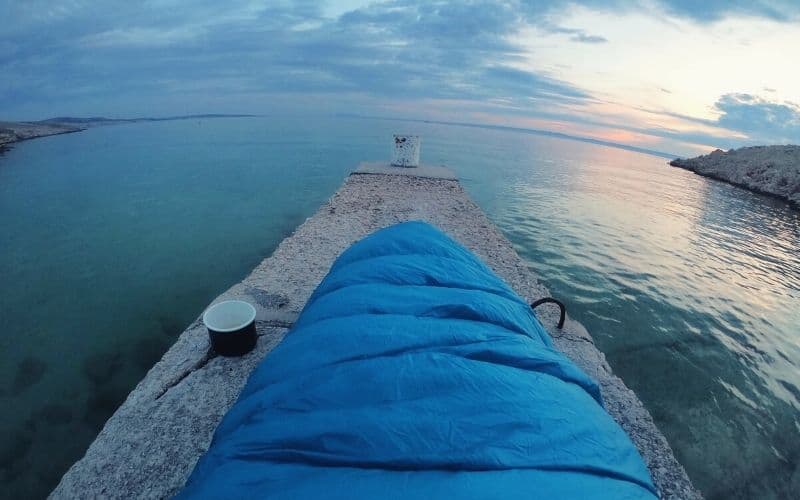
Sleeping Bags Vs. Backpacking Quilts
Choosig between a sleeping bag and quilt is a matter of personal preference, but there are a few differences worth noting.
The most significant difference is that, while both have insulation to keep you warm in cold weather, only a sleeping bag will enclose your entire body.
A backpacking quilt is designed with only a top layer of insulation and is intended to be strapped to your sleeping pad. This reduces weight as it removes the insulation under your body. As such, quilts have a better warmth-to-weight ratio than sleeping pads. However, it does mean sleeping directly on your pad.
Quilts are better suited to warmer conditions where nighttime temperatures don’t dip below freezing. They’re a favorite among backpackers who wish to shave weight, and for anyone who is an active sleeper or feels claustrophobic wrapped up in a mummy bag.
In cold and windy weather, we’d always opt for mummy bags as they trap body heat more efficiently and are less drafty.
Conclusion
To conclude, we believe the best backpacking sleeping bag you can buy is the Feathered Friends Hummingbird 20F. This bag is ultralight, toasty warm, and packs down to a tiny bundle, making it a great pick for 3-season backpacking. If the Hummingbird is too pricey, the Kelly Cosmic Down and Nemo Disco are solid alternatives if you don’t mind carrying a little extra weight.
If you have any questions or comments, drop us a line in the box below. And if you’d like to share this post, please do!
